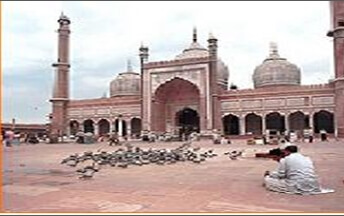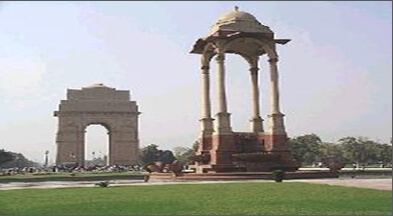Day 01: Arrive Delhi
You will arrive at New Delhi’s International Airport. Following customs, immigration formalities and baggage collection, our airport representative will meet you as you EXIT the ARRIVAL TERMINAL building after which you would be transferred to your hotel.
Upon arrival at the hotel, check-in at the hotel
India’s capital and a major gateway to the country, contemporary Delhi is a bustling metropolis, which successfully combines in its folds – the ancient with the modern. Amidst the fast spiraling skyscrapers the remnants of a bygone time in the form of its many monuments stand as silent reminders to the region’s ancient legacy. The first impressions for any visitor traveling in from the airport are of a specious, garden city, tree-lined with a number of beautiful parks.
You will first visit Old Delhi. The tour will begin with a visit to Raj Ghat, a simple memorial to Mahatma Gandhi; Later, drive to Red Fort for Photo stop from outside after that walking tour to the Jama Masjid, one of Asia’s largest mosques and which is viewed from the outside. People stream in and out of the mosque continuously and the presence of a nearby bazaar means that the area is rarely quiet.
The tour also includes a drive past the imposing India Gate, the Parliament building and the Rastrapathi Bhawan, the President’s residence. After visiting Old Delhi, you will be driven to New Delhi, which reflects the legacy the British left behind. The division between New and Old Delhi is the division between the capitals of the British and the Mughals respectively. The division in the walled city and New Delhi also marks the division in the life-styles. The walled city is all tradition where one will be able to glean a past life-style in all its facets, colours and spells. New Delhi in contrast, is a city trying to live up to the best of 21st century standards.
The tour to Imperial Delhi will include a visit to the Qutub Minar, the tallest stone tower in India. Qutub-ud-din Aibak started it in 1199. Pulling down 27 Hindu and Jain temples and using their columns erected the attached Quwwat-ul-Islam mosque also built by him. Then visit Humayun’s tomb, built by the widow of the second Mughal Emperor, Humayun, it is an outstanding monument in the Indo-Persian style, a precursor of the Taj Mahal. Barber’s Tomb which is located on the southwestern side of the Humayun’ tomb also know as Nai-ka-Gumbad. This stands on a raised platform, reached by seven steps from the south. The building is square on plan and consists of a single compartment covered with a double-dome.
Overnight at the hotel
Day 02: Delhi / Agra
Morning after breakfast drive down to Agra (203 KMS / 4.30 Hours) en-route visiting Sikandra Tomb of Emperor Akbar, Akbar began building it during his lifetime and his son, the Mughal Emperor Jahangir, completed it. Some of its design features are similar to the design of the Taj Mahal built later in Agra. Akbar’s tomb at Sikandra has a large arched entrance and green lawns (on which deer can be seen grazing) surround the tomb. Built in the Indo-Saracenic style, Akbar’s tomb at Sikandra is a peaceful setting for a ruler who led an eventful life. Akbar came to the throne aged 13, following the death of his father Humayun. The serene resting place of the great Mughal ruler Akbar, at Sikandra, is a site that invites you to step back into history and contemplate the life and times of Akbar the Great.
Afternoon proceed to visit visit Agra Fort, an outstanding example of Mughal architecture. Agra Fort – the seat and the stronghold of the Mughal Empire under successive generations. This was the seat of Mughal rule and administration and the present structure owes its origins to Akbar who erected the walls and gates and the first buildings on the eastern banks of Yamuna River. Shah Jehan added the impressive quarters and the mosque while Aurangzeb added the outer ramparts. Visit its Hall of Public Audience and its Royal Pavilions.
In the evening proceed to See Taj Mahal (closed on Fridays). Midway ‘’Battery bus’’ would be waiting for you and will drop you at the gates of the Taj Mahal. The Taj Mahal is everything that has been said about it and more. Taking 22 years and 20,000 men to build, the white marble was quarried 200 miles away and was transported to the site by a fleet of 1000 elephants. Built by the Mughal Emperor Shah Jahan as an expression of his love for his wife Mumtaz Mahal, in mid 17th century, the Taj Mahal is truly one of the wonders of the world. Though the Taj appears to be amazingly perfect from almost any angle, it is the close-up marble inlay work, which is really astounding. You will have ample time to view and be mesmerized by this outstanding piece of architecture.
Overnight at the hotel
Day 03: Agra / Fatehpur Sikri / Jaipur
After Breakfast at the hotel, you will be driven to Jaipur (232 Kms/ 4 Hrs)
En-route visiting Fatehpur Sikri, the deserted red sandstone city, built by the Great Mughal Emperor Akbar as his capital and palace in the late 16th century, It was abandoned soon after it was built when the local wells went dry and it remains today in much the same condition that it was over 300 years ago. It is complete with palaces and mosques and used to be a town larger than London when it was originally constructed. Now it is an extraordinary place to wander around with its buildings in near perfect condition.
Upon arrival, check in at the hotel
Overnight at the hotel
Day 04: Jaipur
After breakfast at the hotel, you will proceed for Jaipur city tour. Capital of Amber to see the fabulous Amber Fort. Maharaja Mansingh, Mughal Emperor Akbar’s most successful General, started the construction of Amber Fort in the 17th century. Before the City Palace was constructed in Jaipur, Amber was the seat of power. The fort is surrounded by fortified battlements and overlooks the Moat Lake. Ruins and remains are spread over the Aravalli hills and sprawling crenulated walls lattice the surrounding area sprawling complex of courtyards and halls, Many of the rooms have delightful wall paintings, with precious stones and mirrors inlaid in the walls. Most fascinating, perhaps, is the Sheesh Mahal (hall of mirrors) where a single lamplight is reflected in the many mirrors, lighting up the room.
You will take a photo stop at `Palace of Winds’, otherwise known as Hawa Mahal. It is really an elaborate facade behind which the ladies of the court used to watch the daily goings on in the street below. It is extremely intricate in its pink sandstone carving. The cool wind blows through its facade of windows and latticed screens through which the queens of the court once viewed the streets of the city.
Afternoon, you will visit the City Palace, which is an overwhelming complex of exquisite palaces, gardens and courtyards, decorative art and carved doorways. The palace museum houses collections of rare manuscripts, armoury, costumes, carpets and miniature paintings. Jantar Mantar is the most famous of five observatories built by Sawai Jai Singh in India. Jai Singh was a great admirer of progresses and research made in the fields of science and technology, but he was passionate about astronomy. There is a very interesting story behind the construction of this observatory, considered as the largest stone observatory in the world. Sawai Jai Singh sent his emissaries to all parts of the world before commencing the construction of this observatory. The emissaries returned with many manuals on astronomy containing cutting-edge technological information. One of these manuals was a copy of La Hire’s “Tables”. The king ordered the observatory to be built according to the details contained in this manual. When the construction ended, for the astonishment of the king and others, the observatory was 20 seconds more accurate than the one mentioned in “Table.
In the evening drive back to Delhi, upon arrival, check in at the hotel
Overnight at the hotel
Day 05:Jaipur / Ajmer / Jaipur / Mumbai
After breakfast at the hotel, Drive to Ajmer (125 Kms/ 2 Hrs)
Upon arrival, visit Khwaja Moinduddin Chistti Dargarh, Moinuddin Chishti (1141 – 1236) also known as Gharib Nawaz (Benefactor of the Poor), was an imam, Islamic scholar and philosopher from South Asia. Chishti introduced and established the Chishti Order of Sufism in the Indian subcontinent. The initial spiritual chain or silsila of the Chishti order in India, comprising Chishti, Qutbuddin Bakhtiar Kaki, Fariduddin Ganjshakar and Nizamuddin Auliya—each successive person being the disciple of the previous—includes the great Sufi saints of Indian history.Various Mughal emperors were followers of Chishti.
Afternoon, drive back to Jaipur to board the flight to Mumbai
Upon arrival, check in at the hotel
Overnight at the hotel
Day 06: Mumbai
After breakfast at the hotel, full day city tour of Mumbai including Gateway of India, Marine drive, Chhattrapati Shivaji Terminal, Bollywood Tour etc
Evening free for shopping
Overnight at the hotel
Day 07: Mumbai Departure
After breakfast, transfer to Mumbai airport to board the flight for onward destination







